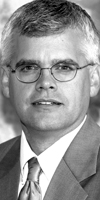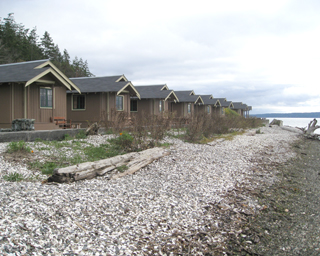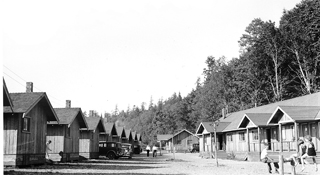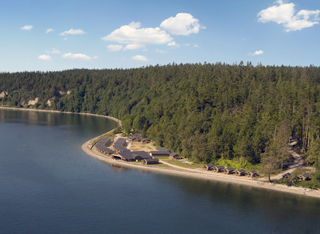
DJC.COM
November 19, 2009
Placid park belies a major engineering effort
Parametrix

McAlister
|
Restoring the former Cama Beach Resort into Washington state’s newest park illustrates many of the challenges of waterfront development.
Located on Camano Island along Puget Sound’s Saratoga Passage, the site’s history dates back more than 2,000 years when Native Americans first set up fishing camps. In 1934, Seattle businessman L.R. Stradley purchased and developed the 434-acre site into an affordable family fishing resort.
When the resort closed in 1989, the family approached the Washington State Parks and Recreation Commission proposing to donate the majority of their land to fulfill the family’s mission of keeping the property open to the public at a low cost and to be enjoyed as an environmental learning center. A partnership between State Parks and Seattle’s Center for Wooden Boats was formed to develop and manage the park.

Photos courtesy of Parametrix Buried below the beachfront is one of the largest midden deposits in the Puget Sound area. To preserve the midden, fill material was brought in to raise the grade. |
The resort now mirrors the historic character of the site during its heyday. Visitors step back in time and experience the historic character of the shoreline, small cabins, boat house and administrative buildings. Hidden from visitors is the extensive engineering effort required to provide sanitary sewer, water, power and fire suppression to the historically, archaeologically and ecologically sensitive beach area.
Parametrix was the prime consultant for the development. The firm was responsible for the master planning, site layout, permitting, utility systems, architecture, preservation, landscape, construction administration and oversight of the archaeological field investigations.
The Cama Beach property is listed on the National Register of Historic Places and has a large group of stakeholders: the Parks Commission, previous resort owners, tribes, the Center for Wooden Boats, and local, state and federal agencies. In addition, several environmental issues were involved in acquiring permits.
Ancient fishing camp
| Cama Beach State Park |
|
Owner: Washington State Parks Project manager/ prime consultant: Parametrix Construction manager: Mark J. VanVliet Architect General contractor: Advanced Construction Mechanical engineer: FSi Consulting Engineers Geotechnical engineer: AMEC Earth & Environmental Archaeologist: Cascadia Archaeology |
In 2005, archaeologists uncovered human remains and other artifacts on the property, requiring changes in the site layout and solutions that would minimize any impacts to the buried archaeological cultural features. The future retreat lodge and dining hall were relocated to a hillside site and utility alignments were modified to protect these areas of cultural significance.
Buried below the beachfront site is one of the largest midden deposits within the Puget Sound area, believed by archaeologists to be the remnants of a seasonal shellfish and fish gathering camp used from 300 to 1,600 years ago. To preserve the integrity of the midden, a significant amount of fill material was brought in to raise the grade. Utilities and other park facilities were sited to avoid the midden areas. Where disturbance could not be avoided, a detailed archaeological investigation was performed to document the characteristics of these cultural deposits.
The project required all-new utility systems for the park, so all utility trenches were excavated, examined and documented by the archaeologist, assisted by members local tribes. This pre-work reduced the risk of delays and potentially costly contractor delays or claims during the construction phase of the project.
Wastewater treatment
To address failed septic systems and minimize the impacts to the beach area and overall costs, Parametrix designed a system of gravity sewers, grinder pump stations and sewer forcemains to collect and convey the wastewater to a 13,500 gallons per day on-site sewage disposal facility. This facility incorporated a subsurface drip system, a new technology recently approved by the Washington State Department of Health.

A Seattle businessman developed Cama Beach into an affordable family fishing resort in 1934, but the site’s history goes back more than 2,000 years. |
The drip system reduced the footprint of the site disturbance, accommodated the site soil conditions, and was less costly and less environmentally intrusive than a traditional drainfield. The treatment system and dispersal fields are located on the upper area of the site, out of view from occupied areas.
Sustainable features
An energy management system was incorporated into the park’s new infrastructure to help manage the heating costs of the guest cabins, the future retreat lodge and other facilities. Motion detectors, digital thermostats and centralized automatic controls operate cabin heating units, providing significant energy savings during periods of low use. On-demand water heaters, low-flow fixtures and energy-efficient lighting systems were also installed to meet the sustainability goals.
Sustainable construction practices and materials, including reclaimed timber and locally sourced materials were used during construction renovation.

The 434-acre Cama Beach State Park has several dozen cabins and a boathouse. Future development will include a retreat lodge, dining hall, marine facility, and an operations and amaintenance facility. |
The architectural design and planning for the park’s historic rehabilitation, as well as for the new buildings, began by documenting contributing architectural resources and measuring and drawing all structures as would be required by the National Park Service. By carefully analyzing the unique architectural characteristics of the historic structures, the architect was able to incorporate these elements into the design of the new facilities.
Future development phases within the park include a marine facility, a new retreat lodge and dining hall, and a new maintenance and operations facility for parks staff.
A positive reception
Since the park’s opening last year, the waterfront cabins have been fully booked and the public’s positive response has been overwhelming. The partnership with the Center for Wooden Boats and local concessionaires is stimulating local businesses, as well as providing public education on the art of boat building.
The project has received recognition from many corners. It received a silver award from the American Council of Engineering Companies of Washington in the special projects category, a public works “project of the year” award for historical restoration/preservation from the American Public Works Association, and a place on Sunset magazine’s list of “top 10 hideaways by the sea.”
Damon McAlister was the Cama Beach State Park project manager for Parametrix. As a senior engineer, McAlister manages the design and construction administration of large site-development projects in the Puget Sound area.
Other Stories:
- Bellingham embarking on ambitious waterfront plan
- Magnolia Bridge complicates pier project
- 21st-century waterfronts: What makes them work?
- Bellevue reconnecting with its waterfront
- Planning a shoreline project? Win over the public first
- Kennewick island lighthouse a beacon for downtown
Copyright ©2009 Seattle Daily Journal and DJC.COM.
Comments? Questions? Contact us.